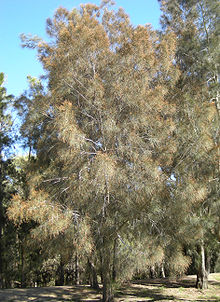
Casuarina equisetifolia, commonly known as coastal she-oak, horsetail she-oak, ironwood,beach sheoak, beach casuarina or whistling tree is a species of flowering plant in the family Casuarinaceae and is native to Australia, New Guinea, Southeast Asia and India. It is a small to medium-sized, monoecious tree with scaly or furrowed bark on older specimens, drooping branchlets, the leaves reduced to scales in whorls of 7 or 8, the fruit 10–24 mm (0.39–0.94 in) long containing winged seeds (samaras) 6–8 mm (0.24–0.31 in) long. It has been called ironwood, horsetair tree, beach sheoak, and Australian pine, though it is not pine despite some of its conifer like features.

Casuarina, also known as Australian pine and native pine, is a genus of flowering plants in the family Casuarinaceae, and is native to Australia, the Indian subcontinent, Southeast Asia, islands of the western Pacific Ocean, and eastern Africa.

Allocasuarina lehmanniana, commonly known as dune sheoak, is a species of flowering plant in the family Casuarinaceae and is endemic to near-coastal areas of the south-west of Western Australia. It is dioecious or less commonly a monoecious shrub that has its leaves reduced to scales in whorls of six to eight, the mature fruiting cones 12–35 mm (0.47–1.38 in) long containing winged seeds (samaras) 4.0–5.5 mm (0.16–0.22 in) long.

Allocasuarina torulosa, commonly known as forest oak, rose sheoak, river oak or Baker's oak, is a species of flowering plant in the family Casuarinaceae and is endemic to eastern Australia. It is a slender, usually dioecious tree that has drooping branchlets up to 140 mm (5.5 in) long, the leaves reduced to scales in whorls of four or five, and the fruiting cones 15–33 mm (0.59–1.30 in) long containing winged seeds 7–10 mm (0.28–0.39 in) long.

Allocasuarina distyla, commonly known as scrub she-oak, is a species of flowering plant in the family Casuarinaceae and is endemic to south-eastern New South Wales. It is a dioecious shrub that has branchlets up to 350 mm (14 in) long, the leaves reduced to scales in whorls of six to eight, the fruiting cones 13–35 mm (0.51–1.38 in) long containing winged seeds (samaras) 4.0–8.0 mm (0.16–0.31 in) long.
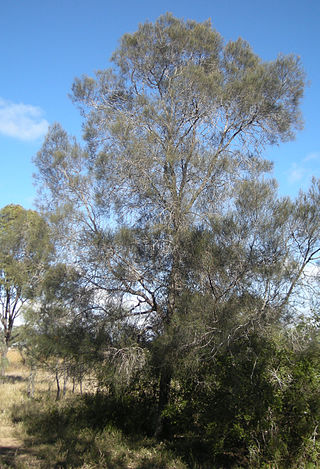
Allocasuarina luehmannii, commonly known as buloke or bull-oak, is a species of flowering plant in the family Casuarinaceae and is endemic to south-eastern continental Australia. It is a dioecious tree, that has its leaves reduced to scales in whorls of ten to fourteen, and the mature fruiting cones are 5–12 mm (0.20–0.47 in) long containing winged seeds (samaras) 4–5 mm (0.16–0.20 in) long.

Casuarina glauca, commonly known as swamp she-oak, swamp buloke, swamp she-oak, marsh sheoak, grey she-oak, grey she-oak, native pine, or guman by the Gadigal people, is a species of flowering plant that is endemic to eastern Australia. It is a dioecious tree that often forms root suckers and has fissured and scaly bark, spreading or drooping branchlets, the leaves reduced to scales in whorls of 12 to 20, the fruit 9–18 mm (0.35–0.71 in) long containing winged seeds (samaras) 3.5–5.0 mm (0.14–0.20 in) long.

Allocasuarina verticillata, commonly known as drooping sheoak, is a species of flowering plant in the family Casuarinaceae and is endemic to south-eastern Australia. It is a small dioecious tree that has drooping branchlets up to 400 mm (16 in) long, the leaves reduced to scales in whorls of nine to thirteen, the mature fruiting cones 20–50 mm (0.79–1.97 in) long containing winged seeds 7–12 mm (0.28–0.47 in) long.

Allocasuarina littoralis, commonly known as black she-oak, is a species of flowering plant in the family Casuarinaceae and is endemic to eastern Australia. It is dioecious, or less commonly a monoecious tree or shrub, that has its leaves reduced to scales, usually in whorls of six to eight, the mature fruiting cones 10–30 mm (0.39–1.18 in) long containing winged seeds (samaras) 4.0–10 mm (0.16–0.39 in) long.
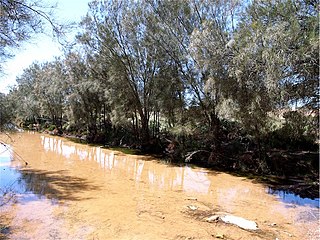
Casuarina obesa, commonly known as swamp she-oak, swamp oak or western swamp oak, or as goolee, kweela, kwerl and quilinock by the Noongar peoples, is a species of flowering plant in the family Casuarinaceae and is endemic to southern continental Australia. It is a dioecious small tree or shrub that forms root suckers, and has drooping or spreading branchlets, the leaves reduced to scales in whorls of 12 to 16, the fruit 10–20 mm (0.39–0.79 in) long containing winged seeds (samaras) 3–5 mm (0.12–0.20 in) long.
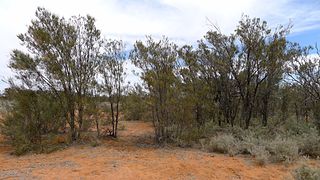
Casuarina pauper, commonly known as black oak, belah or kariku, is a species of flowering plant in the family Casuarinaceae and is endemic to southern continental Australia. It is a dioecious tree with fissured or scaly bark, waxy branchlets, the leaves reduced to scales in whorls of 9 to 13, the fruit 13–18 mm (0.51–0.71 in) long containing winged seeds (samaras) 5.5–7.0 mm (0.22–0.28 in) long.

Casuarina cristata, commonly known as belah or muurrgu, is a species of flowering plant in the family Casuarinaceae and is endemic to inland eastern Australia. It is a tree with fissured or scaly bark, sometimes drooping branchlets, the leaves reduced to scales in whorls of 8 to 12, the fruit 13–18 mm (0.51–0.71 in) long containing winged seeds (samaras) 6.0–10.5 mm (0.24–0.41 in) long.

Allocasuarina inophloia, commonly known as stringybark she-oak, is a species of flowering plant in the family Casuarinaceae and is endemic to eastern Australia. It is a small dioecious tree that has finely fibrous, ribbony bark, its leaves reduced to scales in whorls of seven to nine, the mature fruiting cones 10–20 mm (0.39–0.79 in) long containing winged seeds (samaras) 5–6 mm (0.20–0.24 in) long.

Allocasuarina paradoxa is a species of flowering plant in the family Casuarinaceae and is endemic to Victoria. It is a dioecious or monoecious shrub that has branchlets up to 150 mm (5.9 in) long, the leaves reduced to scales in whorls of seven to eleven, the fruiting cones 13–25 mm (0.51–0.98 in) long containing winged seeds 4–8 mm (0.16–0.31 in) long.

Allocasuarina acutivalvis is a species of flowering plant in the family Casuarinaceae and is endemic to the southwest of Western Australia. It is a dioecious shrub to small tree that has erect branchlets, the leaves reduced to scales in whorls of 10 to 14, the fruiting cones 15–35 mm (0.59–1.38 in) long containing winged seeds (samaras) 6–12 mm (0.24–0.47 in) long.

Allocasuarina eriochlamys is a species of flowering plant in the family Casuarinaceae and is endemic to inland areas of Western Australia. It is a dense, erect, monoecious or dioecious shrub that has more or less erect branchlets, its leaves reduced to scales in whorls of eight to ten, the mature fruiting cones 20–45 mm (0.79–1.77 in) long containing winged seeds (samaras) 5.0–10.5 mm (0.20–0.41 in) long.
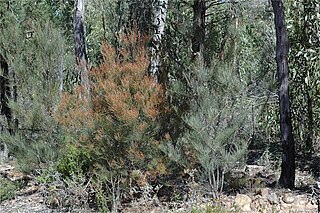
Allocasuarina diminuta is a species of flowering plant in the family Casuarinaceae and is endemic to eastern New South Wales. It is a dioecious or monoecious shrub or small tree that has branchlets up to 230 mm (9.1 in) long, the leaves reduced to scales in whorls of six to ten, the fruiting cones 5–20 mm (0.20–0.79 in) long containing winged seeds (samaras) 3.5–5.0 mm (0.14–0.20 in) long.

Allocasuarina muelleriana, commonly known as slaty sheoak, is a species of flowering plant in the family Casuarinaceae and is endemic to southern continental Australia. It is a dioecious, rarely a monoecious shrub that has branchlets up to 120 mm (4.7 in) long, the leaves reduced to scales in whorls of five to eight, the fruiting cones 14–30 mm (0.55–1.18 in) long containing winged seeds 6–9 mm (0.24–0.35 in) long.
Allocasuarina filidens, commonly known as the Mt Beerwah she-oak, is a species of flowering plant in the family Casuarinaceae and is endemic to a restricted area of Queensland. It is a dioecious shrub that has more or less erect branchlets up to 200 mm (7.9 in) long, the leaves reduced to scales in whorls of five or six, the fruiting cones 14–30 mm (0.55–1.18 in) long containing winged seeds (samaras) 6.5–9 mm (0.26–0.35 in) long.

Allocasuarina rigida is a species of flowering plant in the family Casuarinaceae and is endemic to eastern Australia. It is a dioecious shrub that has branchlets up to 330 mm (13 in) long, the leaves reduced to scales in whorls of seven to ten, and the fruiting cones 8–27 mm (0.31–1.06 in) long containing winged seeds 3.0–7.5 mm (0.12–0.30 in) long.
